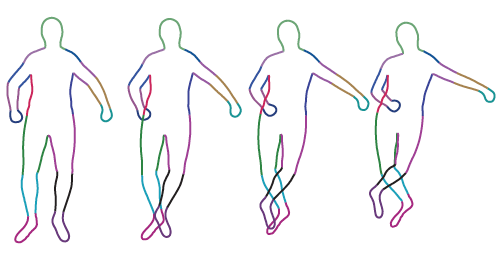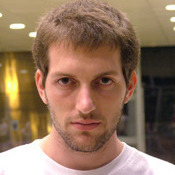Contour people: A parameterized model of 2D articulated human shape
pdf slides video of CVPR talk
We define a new “contour person” model of the human body that has the expressive power of a detailed 3D model and the computational benefits of a simple 2D part-based model. The contour person (CP) model is learned from a 3D SCAPE model of the human body that captures natural shape and pose variations; the projected contours of this model, along with their segmentation into parts forms the training set. The CP model factors deformations of the body into three components: shape variation, viewpoint change and part rotation. This latter model also incorporates a learned non-rigid deformation model. The result is a 2D articulated model that is compact to represent, simple to compute with and more expressive than previous models. We demonstrate the value of such a model in 2D pose estimation and segmentation. Given an initial pose from a standard pictorial-structures method, we refine the pose and shape using an objective function that segments the scene into foreground and background regions. The result is a parametric, human-specific, image segmentation.
| Author(s): | Freifeld, O. and Weiss, A. and Zuffi, S. and Black, M. J. |
| Links: | |
| Book Title: | IEEE Conf. on Computer Vision and Pattern Recognition, (CVPR) |
| Pages: | 639--646 |
| Year: | 2010 |
| Month: | June |
| Publisher: | IEEE |
| Project(s): | |
| Bibtex Type: | Conference Paper (inproceedings) |
| Electronic Archiving: | grant_archive |
BibTex
@inproceedings{Freifeld:CVPR:10,
title = {Contour people: A parameterized model of {2D} articulated human shape},
booktitle = {IEEE Conf. on Computer Vision and Pattern Recognition, (CVPR)},
abstract = {We define a new “contour person” model of the human body that has the expressive power of a detailed 3D model and the computational benefits of a simple 2D part-based model. The contour person (CP) model is learned from a 3D SCAPE model of the human body that captures natural shape and pose variations; the projected contours of this model, along with their segmentation into parts forms the training set. The CP model factors deformations of the body into three components: shape variation, viewpoint change and part rotation. This latter model also incorporates a learned non-rigid deformation model. The result is a 2D articulated model that is compact to represent, simple to compute with and more expressive than previous models. We demonstrate the value of such a model in 2D pose estimation and segmentation. Given an initial pose from a standard pictorial-structures method, we refine the pose and shape using an objective function that segments the scene into foreground and background regions. The result is a parametric, human-specific, image segmentation.},
pages = {639--646},
publisher = {IEEE},
month = jun,
year = {2010},
slug = {freifeld-cvpr-10},
author = {Freifeld, O. and Weiss, A. and Zuffi, S. and Black, M. J.},
month_numeric = {6}
}



